Should you consider buying a used truck crane rather than a new one? There are a few important considerations that can determine whether buying a used crane is a cost effective decision. This article looks at the range and choices of used cranes commonly available, and offers guidance on what to check and how to inspect a used crane, to ensure you make the right purchase.
Table of Contents
The second hand truck crane market
What makes a used truck crane a better buy than a new one?
Second hand truck crane availability
What to consider when looking for a used truck crane
Final thoughts
The second hand truck crane market
The global truck crane market is projected to grow at a compound annual growth rate (CAGR) of around 6% from 2022 to 2025, from a 2022 value of USD 11 billion to a value of USD 20 billion. This growth is driven by a worldwide increase in construction and infrastructure projects.
However, the post-pandemic economic uncertainty makes buyers more cautious of the high investment into new machines, especially with a high number of delayed or canceled projects, and with greater cost pressures and less available capital. Crane manufacturers have also become cautious about boosting production and inventory, leading to less new stock in the market.
Overall, these factors serve to maintain high prices for new cranes and further deter new buyers. Therefore the availability and lower price of used truck cranes has become an attractive option for those looking to buy. The amount of money saved by buying second hand will vary depending on the model, age and hours of use, and overall condition, plus how realistically the seller prices their stock. However, it is generally accepted that new machines lose up to 20% by driving them out of the showroom, and up to another 20% through first use wear and tear. So it is reasonable to estimate that a truck crane with limited use could bring between 20-40% discount off a new machine price.
What makes a used truck crane a better buy than a new one?
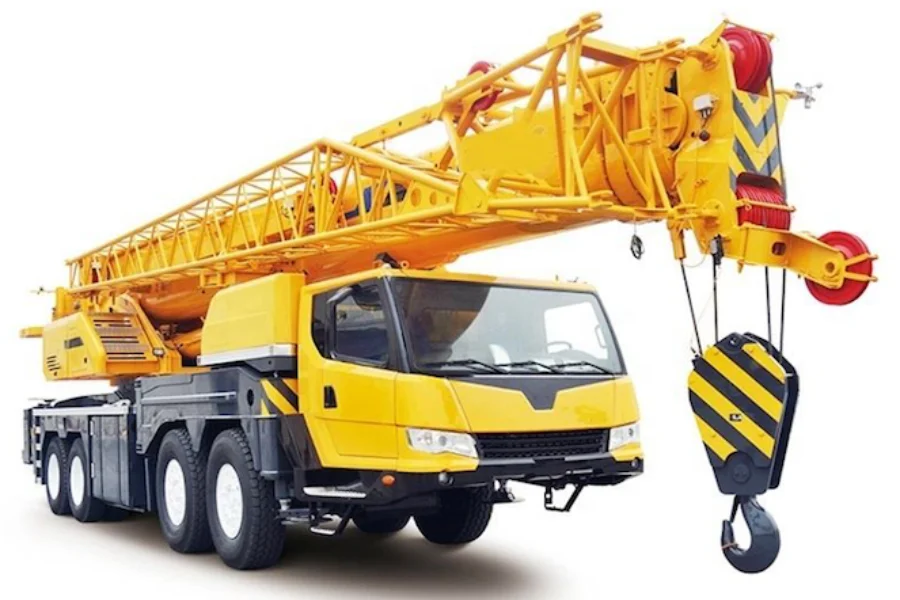
Truck cranes are also known as mobile cranes, boom trucks, truck-mounted cranes (TMCs), or HIABs (a proprietary name that has become a common term for truck cranes). They have a crane boom mounted on a truck bed transport and can come in many sizes, from small flatbed trucks to large multi-wheeled transporters. However truck cranes are usually categorized by their lifting capacity rather than vehicle size, with smaller cranes lifting under 5 tons, to those that can lift over 1200 tons.
Truck cranes offer an advantage over fixed cranes, as they are mobile and can be moved quickly from one job to another, whereas a fixed or tower crane takes time and effort to disassemble and reassemble to be moved. Truck cranes can also carry some small loads with the attached crane, subject to the load capacity of the truck chassis.
Given these benefits of truck cranes, a buyer looking at buying a used model will want to ensure that the potential buy is cost effective and that both the truck and the crane are still fully serviceable. Some key areas to check include:
Road worthiness. The truck must still be road worthy and meet the certification standards of the local authorities. A truck that has not been well maintained and that can’t pass road certification will no longer be a mobile crane without further costs.
Deterioration. Depending on the environment in which the truck crane has been operating, it may show signs of corrosion, damage, or poor repair and replacement. These can all impact the capacity and safety of the truck crane and may require costly fixes to make the machine fully workable.
Lifting capacity. Cranes age and they do lose horsepower over time. Poor hydraulic pressure, worn engine parts and seals, and a general aging of parts, are all factors that can reduce the crane lifting capabilities. So a lifting specification may no longer be achievable.
Maintenance records. A truck crane that has been well maintained and cared for may have a long and extended life. A previous owner should have kept good records or service intervals, fluid and filter changes and any major repairs or replacements.
Second hand truck crane availability
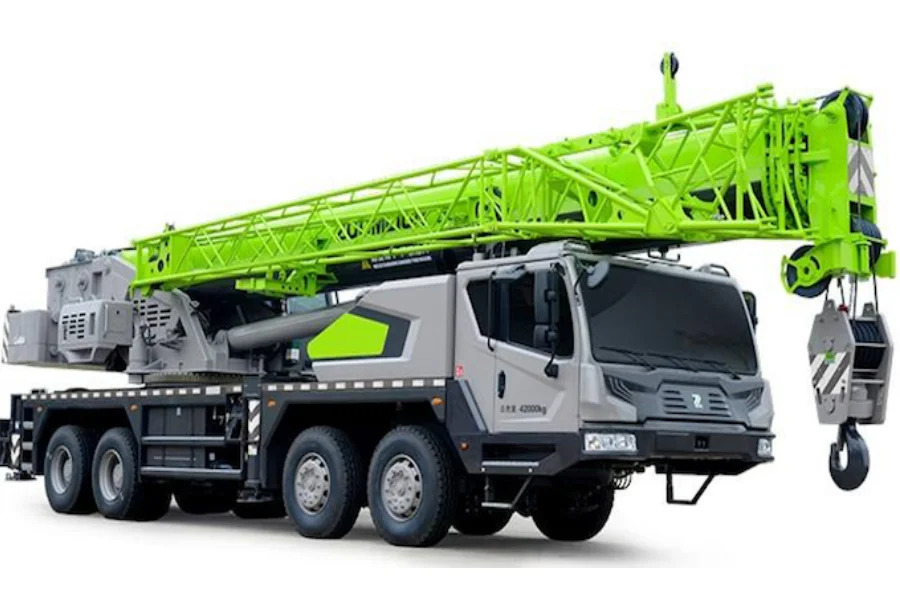
Truck cranes are classified by lifting capacity, as light-duty (under 5 tons), medium-duty (between 5-15 tons), heavy-duty (between 15-50 tons), and extra-heavy-duty (above 50 tons). Typically below 5 tons are trucks with an added crane mount and hand operated boom. From upwards of 5 tons, the crane is operated independently from a separate crane cabin. The wheelbase and number of wheels increases with weight, from 4 wheels for smaller truck cranes, to 10-12 wheels for the heavy cranes. This section looks at a selection of the types, brands and prices of used models under each classification.
Light duty (up to 5 ton)
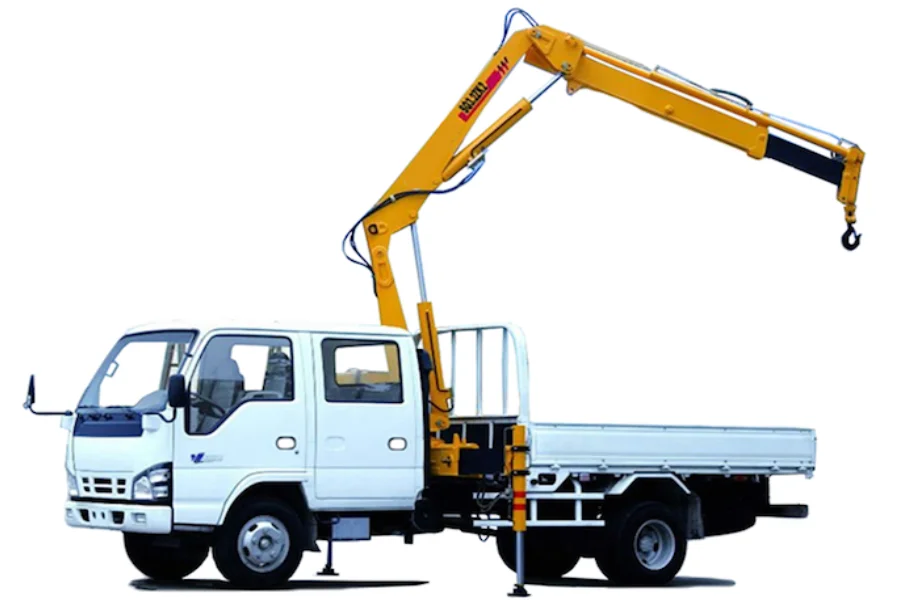
| Model | Power | Lift Capacity | Lift Height | Machine Age | Price (USD) |
|---|---|---|---|---|---|
| Bochi | 7.5Kw | 2 ton | 4m | NA | 20,000 |
| SQ3.2ZK1 | 14Kw | 3.2 ton | 2m | 2019 | 8,000 |
| SQ3.2ZK1 | 14Kw | 3.2 ton | 6.7m | 2020 | 15,000 |
Medium duty (5-15 tons)
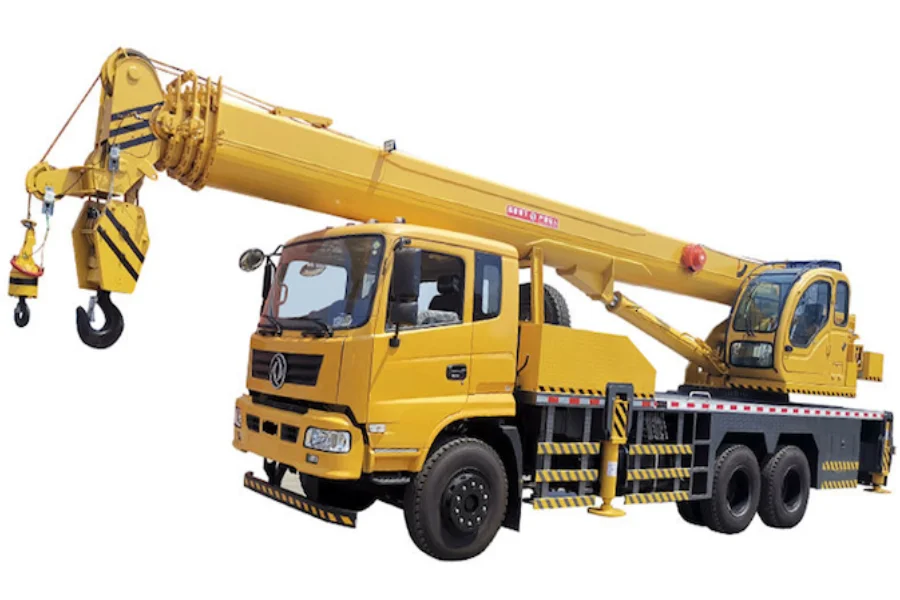
| Model | Power | Lift Capacity | Lift Height | Machine Age | Price (USD) |
|---|---|---|---|---|---|
| Dongfeng EHY5160JSQD | 140Kw | 5 ton | 12m | 2020 | 20,000 |
| China brand jjs-8T | 64Kw | 8 ton | 25m | 2020 | 33,000 |
| Isuzu Giga | 30Kw | 12 ton | 15m | 2018 | 15,300 |
Heavy duty (15-50 ton)
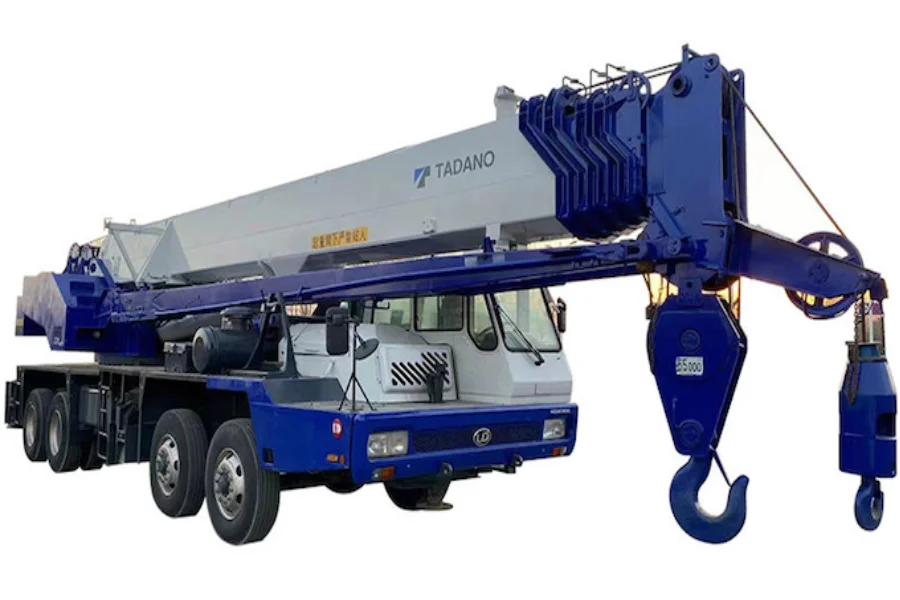
| Model | Power | Lift Capacity | Lift Height | Machine Age | Price (USD) |
|---|---|---|---|---|---|
| Kato NK250E | 247Kw | 25 ton | 35m | 2015 | 31,000 |
| Tadano TG-500E | 260Kw | 50 ton | 42m | 2018 | 65,000 |
| SANY STC750 | NA | 50 ton | 53m | 2016 | 60,000 |
Extra heavy duty (upwards of 50 tons)
| Model | Power | Lift Capacity | Lift Height | Machine Age | Price (USD) |
|---|---|---|---|---|---|
| Zoomlion 100T | NA | 100 ton | 60m | 2018 | 113,000 |
| XCMG QY130K | 162Kw | 130 ton | 42m | 2009 | 250,000 |
| Liebherr LT1300 | 1850Kw | 300 ton | 40m | 2012 | 50,000 |
What to consider when looking for a used truck crane
Many heavy duty machines can be fully functional with a few major part replacements and good maintenance, whereas truck cranes have major safety elements that must be considered. Climate and corrosion, mistreatment, or poor repair or maintenance standards can all impact a truck crane’s capacity and safety.
The two major components of a truck crane are the truck itself (engine, chassis, cab, outriggers, etc), and then the crane (operating cab, turntable, booms, wire rope, hook, etc). This section will look at what to inspect in these main components and their individual parts.
Truck inspection
Truck chassis: Truck chassis will vary depending on the size of crane, but there are basic truck conditions to look for and some that are more specific to carrying a crane. The wheels, tires and axles must be inspected for damage or wear and tear. The truck chassis will need to take the weight of the crane and any objects that it lifts, as well as being mobile and safe to drive. What are the local requirements for road worthiness, and does the truck meet the requirements?
Engine: The engine will need to be in good condition and work well. It must move the truck bed and crane mountings with power and stability. Does the engine look clean and maintained, or are there signs of any leaks? Leaks can come from poor hose fittings, and broken or ill fitting gaskets. Truck cranes are typically diesel engines. Is there any white or black smoke? If the engine is EPA emissions certified, such as Euro 5 or Euro 6, check that the engine is still performing to standards. Check the maintenance records for whether oils, fluids and filters have been changed regularly, and have any major parts been replaced with quality parts?
Truck cab: In a medium to large truck, the main driver’s cabin is separate from the crane operator’s cab. Inspect the driver’s cab for good treatment. Check the gears and brakes, instruments, and make sure all are working correctly. Check the tachometer and compare it to the maintenance record to validate the operational hours of the truck.
Truck bed and counterweights: The counterweights on a truck crane are important to allow the truck and crane to carry heavy loads without tipping over. The counterweights are found at the back of the crane and their function is to offset the potential crane lift load, preventing the truck from tilting in the direction of the lift. Weights are added or removed to cater for the load being lifted. Check the condition of the counterweights.
Outriggers and hydraulics: Truck cranes improve their stability with outriggers. Outriggers extend from the truck bed using hydraulics, and provide much needed stability for the truck by widening its footprint. Check that the outriggers extend and are planted correctly and firmly. Check they retract fully. Check the hydraulics and maintenance record. Check all hoses and fittings for a tight seal, and that there is no sign of leakage.
Crane inspection
Crane operator’s cab: The operator’s cab sits alongside the base of the crane, from where the operator controls the crane. It is designed to give the operator maximum visibility around the truck and crane while maneuvering. Check the controls, instrument panels, joysticks and foot pedals. Check that the glass windows are intact and that visibility is not impaired. Check that the operator’s seat is not broken and has free adjustment.
Turntable and bearings: The turntable holds the base of the crane and connects it to the truck bed. The turntable is designed to rotate through 360 degrees, and takes the weight of the crane boom, hook and attached load. It must turn smoothly without any unevenness or instability, or there may be a problem with the swing bearing, which would be costly to replace.
Telescopic boom: The telescopic boom extends with powerful hydraulics from its parked state to the crane’s maximum reach. The boom holds the main weight of the load. Check that it can extend and retract smoothly and check all hydraulics for leaks that would reduce hydraulic pressure. Check all the boom sections for signs of weakness or damage, such as cracks or welded plate repairs.
Lattice boom: The lattice boom is a framework of steel spars, that give the boom a lattice appearance, and is designed to distribute the weight of the load across the framework. Lattice booms are a fixed length, whereas telescopic booms are designed to extend. Check for broken connections at the joints of the spars, or for any signs of welding or repair. Damaged or broken spars, or poor welding repairs, can all weaken the lattice framework, lessen the maximum lift weight and even cause catastrophic failure.
Jib: If the crane has an optional jib attachment, to extend reach beyond the length of the boom, check the condition of the jib as well as the connecting pins and lugs. If the jib is a lattice jib, check the jib framework in the same way as for a lattice boom.
Sheaves, block and hook: The hook is typically made of heavy durable metal, and may come with a safety latch to prevent the load sliding off. Check that the hook is intact with no cracks and that the safety latch works. Check the block and pins, and the sheaves (pulleys) within it. Check they are intact and not chipped or dented, and that they rotate freely. They should be well greased.
Wire rope: Steel cable, or wire rope, takes the weight of the load from the hook, through the sheaves and boom. Wire rope is subjected to heavy loads and surface wear, and is susceptible to weakening and damage through corrosion. Wire rope must be checked carefully for signs of corrosion and snapped or frayed strands, both on the surface and in the deeper layers. A weakened rope has a high risk of breakage and must be replaced.
Final thoughts
There is a wide choice of used truck cranes on the second hand market, from small 5-10 ton models to the heavy duty 100 tons and more. There are many models available in the +/- 50 ton range, which reflects the typical sizes that are used most. Truck cranes do differ from other heavy machinery, as there is an additional safety requirement in lifting and moving heavy loads. Factors such as corrosion impact a crane more than they would do for a loader or bulldozer, because they can compromise the integrity of the boom and the wire rope and lead to accidents.
Therefore it is important to be able to physically inspect the condition of the crane and to not rely on photos alone. Before ordering online, do ask for as many close-up photos and videos as possible, and for full copies of the maintenance records. A buyer can only fully assess condition after a physical inspection, so they would be wise to choose a supplier that offers a satisfaction or return guarantee. For more information on the wide choices of used truck cranes available, check out the Alibaba.com showroom.




